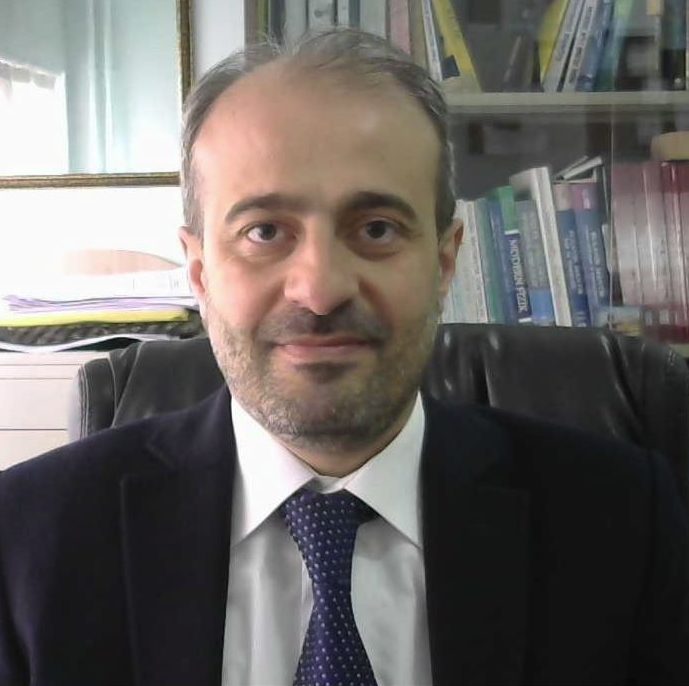Prof. Dr. Fatih KÜLAHCI
Birth: Elazig, Harput
Tel : +90 424 2370000/3835
E-mail : fatihkulahci@firat.edu.tr , fatihkulahci@gmail.com
Addresses:
1) ASELSAN Electronic Industry and Trade Joint Stock Company, TR-06200, Ankara, Türkiye
2) Firat University, Science Faculty, Physics Department, Nuclear Physics Division, TR-23200, Elazig, Türkiye
Languages:English
Professions:
Risk Analysis; Nuclear Technologies & Sciences; Artificial Intelligence; Spatial and Spatiotemporal Analysis; Radiation-Radioactivity; Mathematical Modelling; Stochastic Modelling; Statistical Modelling; Data Analysis; Expert Systems (Neural Network, Fuzzy Logic); Radioactive Fallout; Relations Between Radon and Earthquakes; Nuclear Wastes; MATLAB; Python
PhD: Fırat University 2005,
PPhD: Istanbul Technical University 2008. (Post-Doc)
Assoc. Prof.: Nuclear Physics, 2009
Assoc. Prof.: Department of Statistics and Probability, Michigan State University, USA 2011, (Post-Doc)
Prof.: Nuclear Physics, 2014
Research Interests
Prof. Kulahci emerges as a distinguished figure in the scientific community, boasting a remarkable expertise that traverses a spectrum of domains. His proficiency encompasses Risk Analysis, Spatial and Spatiotemporal Analysis, the intricacies of Radiation and Radioactivity, along with Mathematical and Stochastic Modelling. He’s adept in Expert Systems, particularly in Neural Network and Fuzzy Logic, and demonstrates a deep understanding of Statistical Methods. His insights into Radioactive Fallout and the dynamics between Radon and Earthquakes further solidify his standing.
Prof. Kulahci’s academic odyssey began with significant milestones at Fırat University and Istanbul Technical University and was further enriched by his time at Michigan State University, USA. This journey honed his expertise in Nuclear Physics and Statistics and Probability.
Dr. Külahci has published numerous papers in top-tier journals. He is the owner of 6 modeling methods whose names are given by him in the literature.
Dr. Kulahci’s publications reveal a treasure trove of impactful research. Notably, his work on the Cumulative Ordinary Kriging interpolation model, applied to the Chernobyl and Fukushima incidents, marks a significant stride in environmental science and pollution research. His development of a risk analysis model for radioactive wastes and his exploration of the Absolute Point Cumulative Semivariogram Technique underscore his substantial influence in hazardous materials management.
Prof Kulahci’s research delves into the complex interplay between radon, earthquakes, and environmental variables. research delves into the complex interplay between radon, earthquakes, and environmental variables. His investigations into spatial and statistical uncertainties in radon measurements for earthquake prediction and his utilization of AI models to study radon and Total Electron Content (TEC) anomalies in relation to earthquakes showcase a pioneering blend of geophysics and advanced data analytics. His work in Markov Chain transition probability modeling and ARIMA model simulations in this domain is notable for its methodological innovation and practical application.
Moreover, his research spans a broad range of subjects from the spatial distribution modeling of radiological hazards to the effects of earthquakes on radon and TEC values, and the study of photon exposure and energy absorption in optical lenses. Each of these contributions not only enriches the scientific discourse but also carries profound implications for environmental safety and public health.
In essence, Prof. Kulahci’s work covers an expansive array of vital topics in environmental science, nuclear physics, and statistical modeling. His commitment to employing advanced analytical techniques to address complex, real-world issues is commendable. His contributions are not just academic advancements but are pivotal in their potential societal impact, especially in areas like environmental safety and earthquake prediction.

 orcid.org/0000-0001-6566-4308
orcid.org/0000-0001-6566-4308